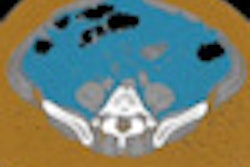
NEW YORK (Reuters Health), Apr 9 - Contrary to what many people have thought, brown adipose tissue appears to be physiologically active in adult humans, according to the results of three studies reported in the New England Journal of Medicine for April 9.
The results also indicate that as body mass index increases, the amount of brown adipose tissue decreases. This finding could have important implications for the treatment of obesity.
Prior research has shown that this type of fat tissue is active in small mammals and infants, but it was thought to have little physiologic relevance in adult humans, Dr. Wouter D. van Marken Lichtenbelt and colleagues from Maastricht University in the Netherlands note.
In their study, van Marken Lichtenbelt's team examined the presence, distribution, and activity of brown adipose tissue in 24 healthy men exposed to cold temperature. The subjects included 10 men who were lean and 14 who were overweight or obese. Integrated PET and CT imaging was used to assess brown fat activity.
During cold exposure (16° centigrade), brown fat activity was seen in 23 of the subjects (96%). Under regular temperature (22° centigrade), no activity was observed. Brown fat increased as metabolic rate climbed and as body mass index fell.
In the second study, which featured 1,972 adults who underwent PET/CT for various reasons, Dr. C. Ronald Kahn, from Harvard Medical School, Boston, and colleagues identified brown adipose tissue in 7.5% of women and in 3.1% of men (p < 0.001). Brown fat mass and activity was higher in women.
Substantial amounts of brown fat extended from the anterior neck to the thorax. The likelihood of finding brown fat was inversely linked to age, outdoor temperature, beta-blocker use, and body mass index.
In the last study, which included five healthy volunteers, Dr. Sven Enerback, from the University of Goteborg, Sweden, showed that cold-induced glucose uptake is increased in paracervical and supracervical fat tissue. Biopsy and testing of the tissue, which was present in substantial amounts, confirmed it to be brown adipose tissue.
"We are hopeful that with increasing ability to measure the mass activity of brown adipose tissue in humans in vivo, we will better understand its role in physiology and its potential as a therapeutic target in the treatment of obesity and other metabolic disorders," Kahn and colleagues conclude.
N Engl J Med 2009;360:1500-1525.
Last Updated: 2009-04-08 17:00:14 -0400 (Reuters Health)
Copyright © 2009 Reuters Limited. All rights reserved. Republication or redistribution of Reuters content, including by framing or similar means, is expressly prohibited without the prior written consent of Reuters. Reuters shall not be liable for any errors or delays in the content, or for any actions taken in reliance thereon. Reuters and the Reuters sphere logo are registered trademarks and trademarks of the Reuters group of companies around the world.


















